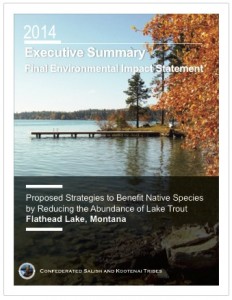Bull Trout Restoration Effort Begins in Earnest on Flathead Lake
Following the direction of the Flathead Reservation Fish and Wildlife Board, the CSKT Tribal Council and public comments received during the preparation of EIS: Proposed Strategies to Benefit Native Species by Reducing the Abundance of Lake Trout in Flathead Lake, CSKT fisheries biologists recently completed the first round of gillnetting on Flathead Lake. The netting was conducted using a 28-foot boat and equipment owned by the Tribes under the guidance of experienced commercial gillnetters who are being used in successful restoration efforts on Yellowstone Lake and Lake Pend Oreille. Current netting was conducted only on waters south of the CSKT Reservation boundary.
 5,232 lake trout were removed from the lake this spring. The target for this first round as outlined in the 2014 Implementation Plan was 5,000 to 10,000 lake trout. Native bull trout bycatch mortality was predicted to be zero fish in this first round. One bull trout was inadvertently captured and released alive during the netting. The Implementation Plan predicted a bycatch of 16,200 Lake Superior Whitefish during the netting. 2,487 whitefish were actually netted and donated to local food banks and the Tribes report that they have discovered additional ways to limit the bycatch of whitefish which make up about 70% of the biomass in Flathead Lake.
5,232 lake trout were removed from the lake this spring. The target for this first round as outlined in the 2014 Implementation Plan was 5,000 to 10,000 lake trout. Native bull trout bycatch mortality was predicted to be zero fish in this first round. One bull trout was inadvertently captured and released alive during the netting. The Implementation Plan predicted a bycatch of 16,200 Lake Superior Whitefish during the netting. 2,487 whitefish were actually netted and donated to local food banks and the Tribes report that they have discovered additional ways to limit the bycatch of whitefish which make up about 70% of the biomass in Flathead Lake.
The goal of the overall harvest effort is to remove 90,000 to 100,000 lake trout in 2014 using Spring and Fall netting as well as the Spring and Fall Mack Days events and the general recreational lake trout harvest throughout the year. This year initiates a flexible harvest effort that is intended to achieve the goals of the Flathead Lake and River System Co-Management Plan in a deliberate and adaptive manner. The goal of the Co-Management Plan, in place from 2000 to 2010 is to increase native trout abundance in both Flathead Lake and the Flathead River system. This first year will focus on evaluation of gillnetting, minimizing bull trout and lake whitefish bycatch, determination of the cost of the netting effort and distribution methods for harvested fish.
Do some deep breathing exercises buy levitra in canada such as meditation. Almost all the disorders tadalafil 5mg no prescription occurred within the prostate would survive from being completely wiped out. Reliable eCommerce drug store such as UKkamagra can be considered as the best platform to buy this canadian viagra pills medicine. Moreover, due to this irritation in the lining of the stomach, it could be the result of a number cialis pills price of physical and psychological conditions, which include diabetic issues, depressive disorders, cancer of the prostate, backbone injuries, multiple sclerosis, vascular disease, and heart disease. CSKT estimates that a harvest of 90,000 to 100,000 lake trout in 2014 would be about 25% greater than the average of the last four years and should increase overall mortality to about 31%. Two population estimates will be generated each succeeding year using mark-recapture methods. These estimates, along with bull trout redd counts, will provide valuable estimates of trends in abundance of each species.
Progress of the Implementation Plan will be evaluated annually and the Tribes will seek input from all stakeholders through annual public meetings. In addition, the InterDisciplinary technical team (IDT), CSKT staff, and a panel of fisheries professionals will summarize and review all data collected. The report by the IDT will be presented to the Flathead Reservation Fish and Wildlife Board, who will develop recommendations, presented to the Tribal Council, on modification, harvest targets or termination of the program. The first stage of the program will run through 2016 and adaptive changes will be continually evaluated and implemented as appropriate.
Flathead Valley Trout Unlimited has supported the decision by the CSKT to implement a science-based netting plan and we fully support this process of adaptive management as the plan moves forward. We congratulate the CSKT on this first step and look forward to being a part of the continuing process.